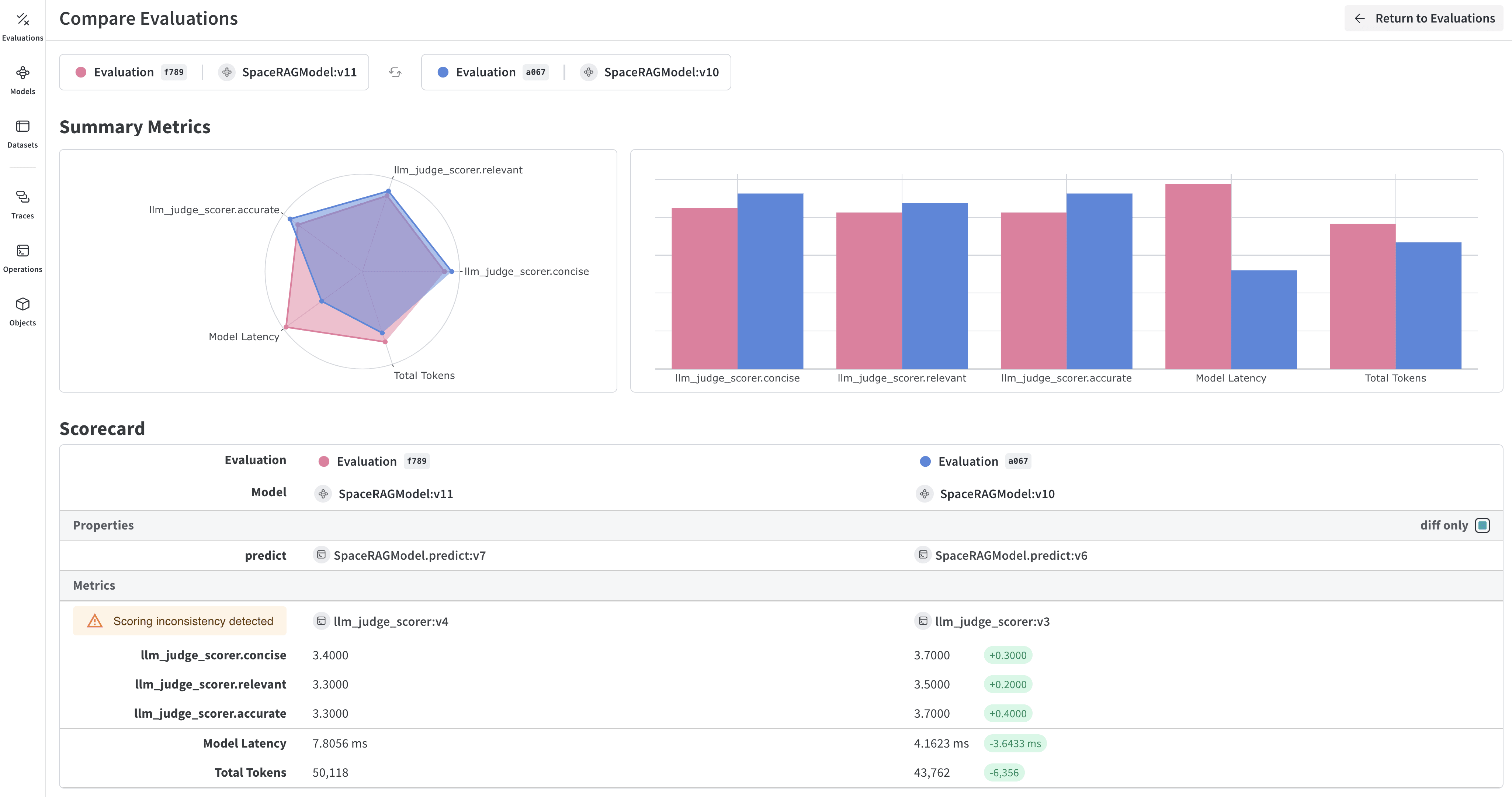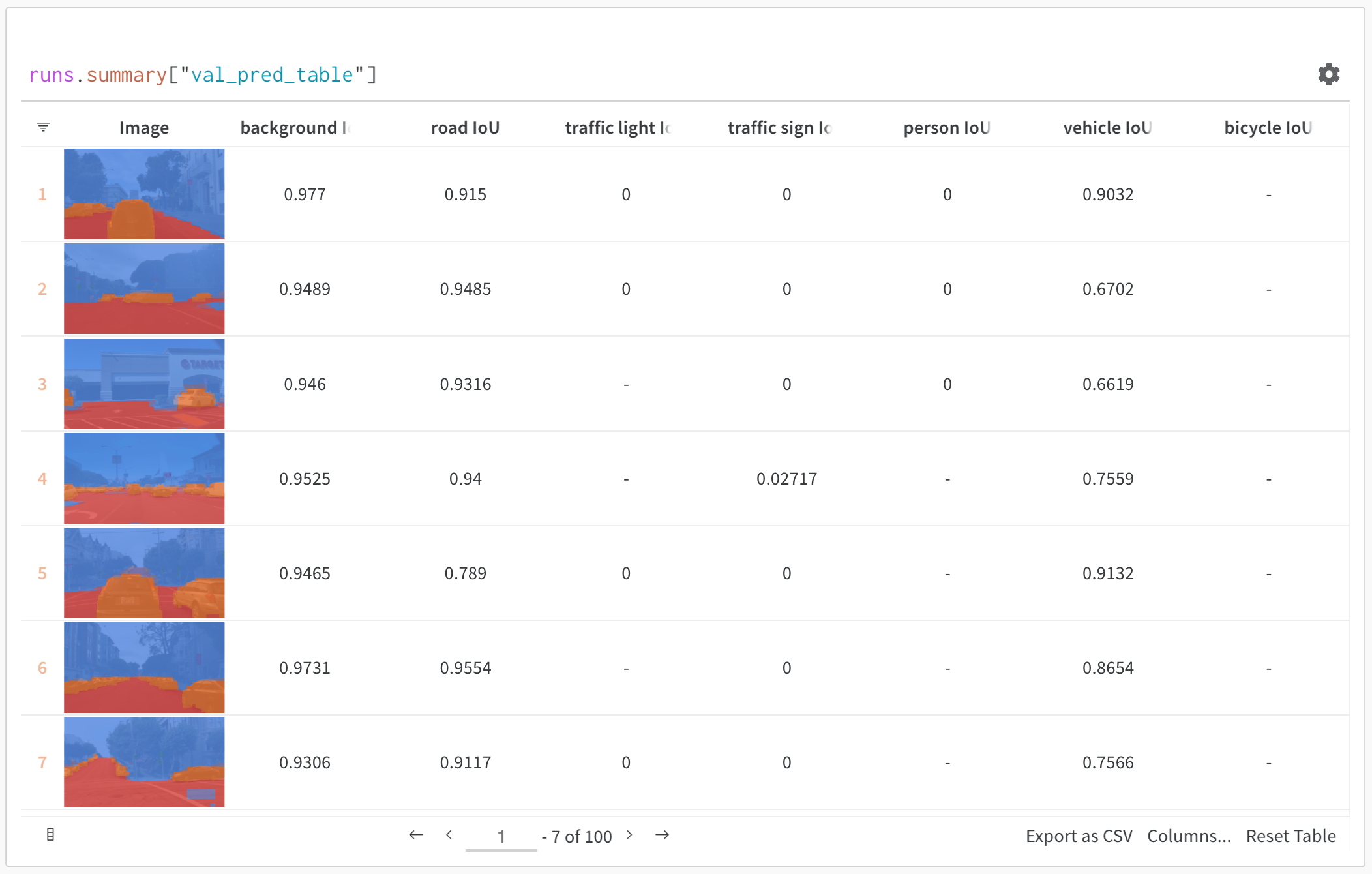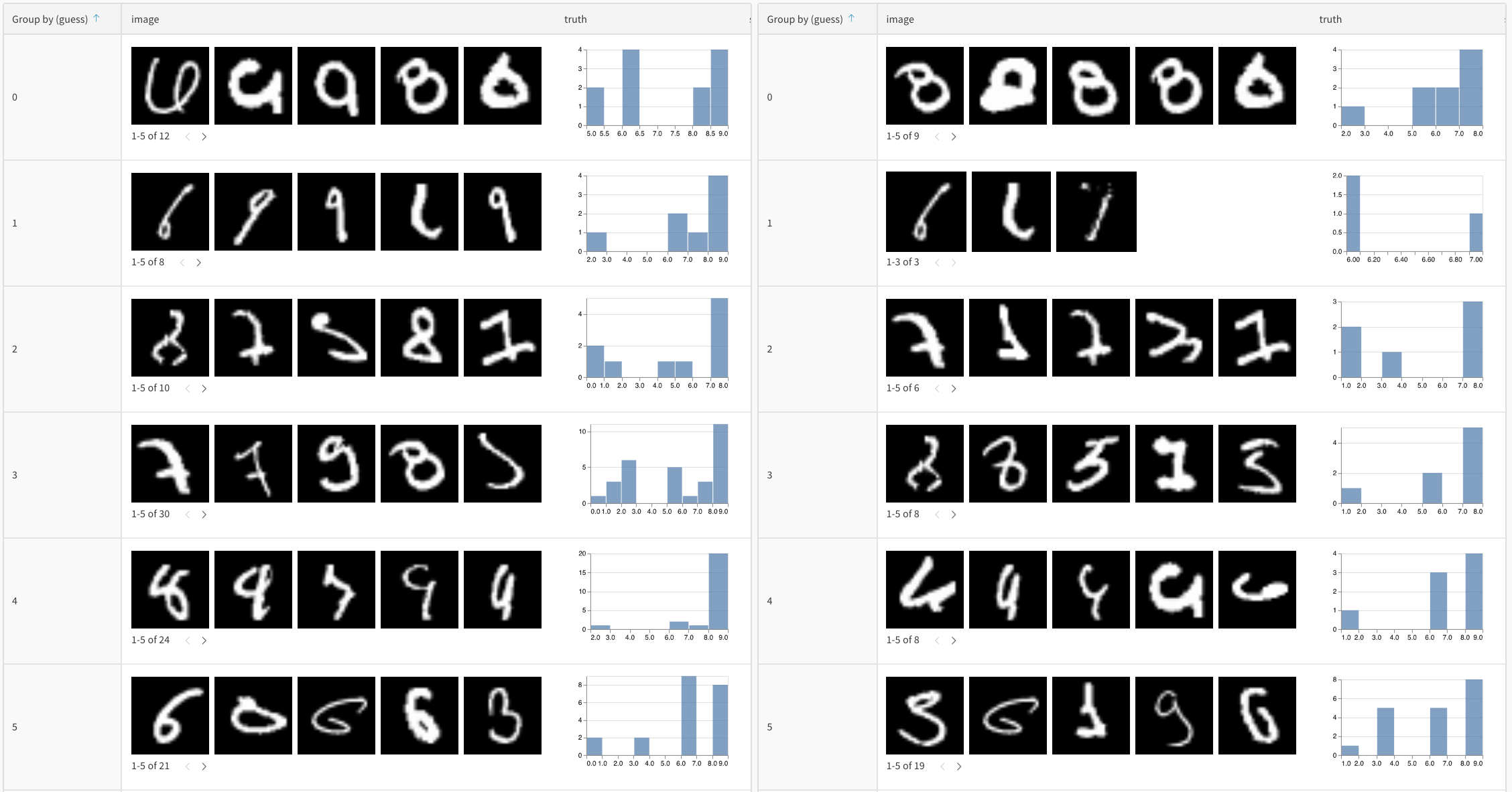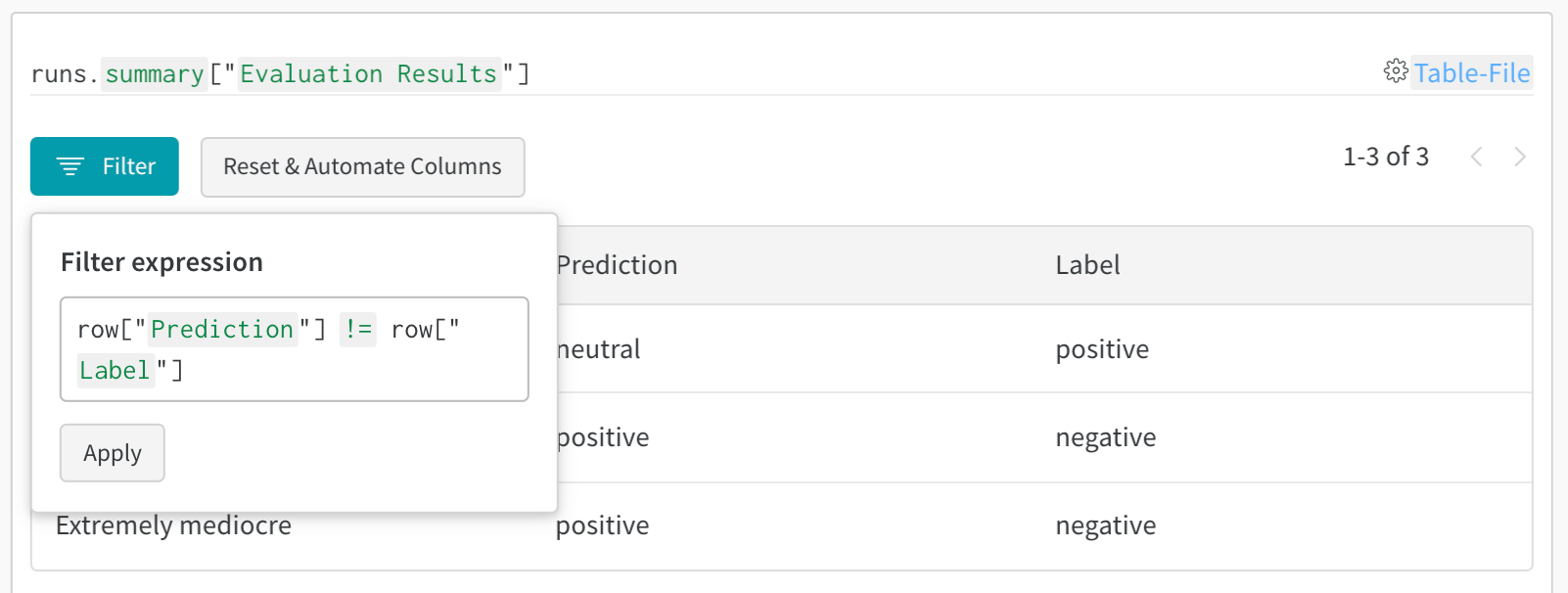Evaluate models
4 minute read
Evaluate models with Weave
W&B Weave is a purpose-built toolkit for evaluating LLMs and GenAI applications. It provides comprehensive evaluation capabilities including scorers, judges, and detailed tracing to help you understand and improve model performance. Weave integrates with W&B Models, allowing you to evaluate models stored in your Model Registry.

Key features for model evaluation
- Scorers and judges: Pre-built and custom evaluation metrics for accuracy, relevance, coherence, and more
- Evaluation datasets: Structured test sets with ground truth for systematic evaluation
- Model versioning: Track and compare different versions of your models
- Detailed tracing: Debug model behavior with complete input/output traces
- Cost tracking: Monitor API costs and token usage across evaluations
Getting started: Evaluate a model from W&B Registry
Download a model from W&B Models Registry and evaluate it using Weave:
import weave import wandb from typing import Any # Initialize Weave weave.init("your-entity/your-project") # Define a ChatModel that loads from W&B Registry class ChatModel(weave.Model): model_name: str def model_post_init(self, __context): # Download model from W&B Models Registry run = wandb.init(project="your-project", job_type="model_download") artifact = run.use_artifact(self.model_name) self.model_path = artifact.download() # Initialize your model here @weave.op() async def predict(self, query: str) -> str: # Your model inference logic return self.model.generate(query) # Create evaluation dataset dataset = weave.Dataset(name="eval_dataset", rows=[ {"input": "What is the capital of France?", "expected": "Paris"}, {"input": "What is 2+2?", "expected": "4"}, ]) # Define scorers @weave.op() def exact_match_scorer(expected: str, output: str) -> dict: return {"correct": expected.lower() == output.lower()} # Run evaluation model = ChatModel(model_name="wandb-entity/registry-name/model:version") evaluation = weave.Evaluation( dataset=dataset, scorers=[exact_match_scorer] ) results = await evaluation.evaluate(model) Integrate Weave evaluations with W&B Models
The Models and Weave Integration Demo shows the complete workflow for:
- Load models from Registry: Download fine-tuned models stored in W&B Models Registry
- Create evaluation pipelines: Build comprehensive evaluations with custom scorers
- Log results back to W&B: Connect evaluation metrics to your model runs
- Version evaluated models: Save improved models back to the Registry
Log evaluation results to both Weave and W&B Models:
# Run evaluation with W&B tracking with weave.attributes({"wandb-run-id": wandb.run.id}): summary, call = await evaluation.evaluate.call(evaluation, model) # Log metrics to W&B Models wandb.run.log(summary) wandb.run.config.update({ "weave_eval_url": f"https://wandb.ai/{entity}/{project}/r/call/{call.id}" }) Advanced Weave features
Custom scorers and judges
Create sophisticated evaluation metrics tailored to your use case:
@weave.op() def llm_judge_scorer(expected: str, output: str, judge_model) -> dict: prompt = f"Is this answer correct? Expected: {expected}, Got: {output}" judgment = await judge_model.predict(prompt) return {"judge_score": judgment} Batch evaluations
Evaluate multiple model versions or configurations:
models = [ ChatModel(model_name="model:v1"), ChatModel(model_name="model:v2"), ] for model in models: results = await evaluation.evaluate(model) print(f"{model.model_name}: {results}") Next steps
Evaluate models with tables
Use W&B Tables to:
- Compare model predictions: View side-by-side comparisons of how different models perform on the same test set
- Track prediction changes: Monitor how predictions evolve across training epochs or model versions
- Analyze errors: Filter and query to find commonly misclassified examples and error patterns
- Visualize rich media: Display images, audio, text, and other media types alongside predictions and metrics

Basic example: Log evaluation results
import wandb # Initialize a run run = wandb.init(project="model-evaluation") # Create a table with evaluation results columns = ["id", "input", "ground_truth", "prediction", "confidence", "correct"] eval_table = wandb.Table(columns=columns) # Add evaluation data for idx, (input_data, label) in enumerate(test_dataset): prediction = model(input_data) confidence = prediction.max() predicted_class = prediction.argmax() eval_table.add_data( idx, wandb.Image(input_data), # Log images or other media label, predicted_class, confidence, label == predicted_class ) # Log the table run.log({"evaluation_results": eval_table}) Advanced table workflows
Compare multiple models
Log evaluation tables from different models to the same key for direct comparison:
# Model A evaluation with wandb.init(project="model-comparison", name="model_a") as run: eval_table_a = create_eval_table(model_a, test_data) run.log({"test_predictions": eval_table_a}) # Model B evaluation with wandb.init(project="model-comparison", name="model_b") as run: eval_table_b = create_eval_table(model_b, test_data) run.log({"test_predictions": eval_table_b}) 
Track predictions over time
Log tables at different training epochs to visualize improvement:
for epoch in range(num_epochs): train_model(model, train_data) # Evaluate and log predictions for this epoch eval_table = wandb.Table(columns=["image", "truth", "prediction"]) for image, label in test_subset: pred = model(image) eval_table.add_data(wandb.Image(image), label, pred.argmax()) wandb.log({f"predictions_epoch_{epoch}": eval_table}) Interactive analysis in the W&B UI
Once logged, you can:
- Filter results: Click on column headers to filter by prediction accuracy, confidence thresholds, or specific classes
- Compare tables: Select multiple table versions to see side-by-side comparisons
- Query data: Use the query bar to find specific patterns (for example,
"correct" = false AND "confidence" > 0.8) - Group and aggregate: Group by predicted class to see per-class accuracy metrics

Example: Error analysis with enriched tables
# Create a mutable table to add analysis columns eval_table = wandb.Table( columns=["id", "image", "label", "prediction"], log_mode="MUTABLE" # Allows adding columns later ) # Initial predictions for idx, (img, label) in enumerate(test_data): pred = model(img) eval_table.add_data(idx, wandb.Image(img), label, pred.argmax()) run.log({"eval_analysis": eval_table}) # Add confidence scores for error analysis confidences = [model(img).max() for img, _ in test_data] eval_table.add_column("confidence", confidences) # Add error types error_types = classify_errors(eval_table.get_column("label"), eval_table.get_column("prediction")) eval_table.add_column("error_type", error_types) run.log({"eval_analysis": eval_table}) Feedback
Was this page helpful?
Glad to hear it! If you have more to say, please let us know.
Sorry to hear that. Please tell us how we can improve.